Topics
Category
Era
Minnesota State Sanatorium for Consumptives, Cass County
Edgar Allen Poe's wife, Virginia, was singing at the piano when she coughed. Crimson droplets appeared on her lips, the first sign of tuberculosis, or consumption, as it was called. Her illness inspired "The Mask of the Red Death," a gothic tale whose protagonist refuses to recognize death's inevitability. Poe himself was devastated when Virginia died in January 1847.
A half-century later, tuberculosis was still a scourge. In Minnesota, more than 20,000 people died of the disease between 1887 and 1899. At the time, the only widely accepted treatment was fresh air and a healthy environment, which stimulated the body's immune system. The therapy did not always work but, lacking a suitable alternative, officials across the country erected sanatoriums to quarantine and treat patients.
In 1906, construction began for the Minnesota State Sanatorium for Consumptives, or Ah-Gwah-Ching, about three miles south of Walker in Cass County. Overlooking Shingobee Bay on the south shore of Leech Lake, the hospital evolved into a massive complex of distinctive buildings exhibiting Colonial Revival, Tudor Revival, and Spanish Colonial Revival styles.
The sanatorium adopted new procedures as they arose. Artificial pneumothorax, for example, involved collapsing a diseased lung, which inhibited growth of tubercule bacilli. Patients survived on one lung while the damaged one healed. Then, in the 1940s came antibiotics, which were so successful at killing the bacterium that tuberculosis was almost eradicated in America by the 1960s.
As cases plummeted, tuberculosis hospitals began closing. After serving nearly 14,000 patients, the Minnesota sanatorium was shuttered in 1962, eventually reopening as a nursing home. The facility was added to the National Register of Historic Places in 2001.
It closed in 2008, and the state divided the land, giving fifty acres to the Minnesota Department of Natural Resources for a wildlife management area, selling sixty acres to Cass County at a low price for its use, and offering the remainder for public sale. All buildings at the site, with the exception of a small gazebo, have been torn down, and the site has been made ready for future development.
Bibliography
Anderson, Rolf T. "Minnesota State Sanatorium for Consumptives." National Register of Historic Places Registration Form, September 1996. State Historic Preservation Office, Minnesota Historical Society, St. Paul.
Lundquist, Monica. "Ah-Gwah-Ching: Land ready and waiting for a developer." Brainerd Dispatch, November 10, 2010.
Silverman, Kenneth. Edgar A. Poe: Mournful and Never-ending Remembrance. New York: HarperCollins, 1991.
Related Resources
Primary
Oral History Interview Transcripts, 1970s
Minnesota State Sanatorium for Consumptives
State Archives Collection, Minnesota Historical Society, St. Paul
Description: Transcripts of interviews with thirty-one former patients and staff of the sanatorium and nursing home.
Patient Records, 1908–1975
Minnesota State Sanatorium for Consumptives
State Archives Collection, Minnesota Historical Society, St. Paul
Description: Individual records of patients who were treated at the Minnesota State Sanatorium for Consumptives.
Photographs and Architectural Drawings, c.1927–1981
Minnesota State Sanatorium for Consumptives
State Archives Collection, Minnesota Historical Society, St. Paul
Description: Photographs and architectural drawings documenting the buildings, staff, patients, and activities of the sanatorium.
RC313.M6 A3
The Pine Knot, 1914–1925
Description: A monthly periodical published by the patients of the Minnesota State Sanatorium for Consumptives, or Ah-Gwah-Ching.
RC313.M6 A32
The Moccasin, April 1938–April 1948.
Description: A monthly periodical published by the patients of the Minnesota State Sanatorium for Consumptives, or Ah-Gwah-Ching.
Secondary
100 Years of Caring: Minnesota State Sanatorium for Consumptives, 1907–1961; Ah-Gwah-Ching Nursing Home, 1962–1990; Ah-Gwah-Ching Center, 1991–2007. [Minnesota, s.n.], 2007.
Gardner, Denis. "Minnesota State Sanatorium for Consumptives, Cass County." Minnesota History 59, no. 7 (Fall 2005): 271.
http://collections.mnhs.org/MNHistoryMagazine/articles/59/v59i07p270-271.pdf
Lass, William E. "Minnesota: An American Siberia?" Minnesota History 49, no. 4 (Winter 1984): 149–155.
http://collections.mnhs.org/MNHistoryMagazine/articles/49/v49i04p149-155.pdf
Myers, J. Arthur. "Entrance, Rise and Fall of Tuberculosis in Minnesota." Minnesota Medicine 60, no. 9 (September 1977): 679–684.
———. Invited and Conquered: Historical Sketch of Tuberculosis in Minnesota. [St. Paul: Minnesota Public Health Association], 1949.
Oliver, Skip. A Brief History of the Minnesota State Sanatorium/Ah-Gwah-Ching Nursing Home, 1907–1982: In Commemoration of Our 75th Diamond Jubilee. Ah-Gwah-Ching, MN: [s.n.], 1982.
Staumanis, Andris. "A History of the Ah-Gwah-Ching Treatment Center." Minnesota Public Radio, July 26, 2004.
http://news.minnesota.publicradio.org/features/2004/07/26_straumanisa_agcsidebar/
Wilson, Leonard G. "The Rise and Fall of Tuberculosis in Minnesota." Bulletin of the History of Medicine 66 (1992): 16–52.
Web
The Minnesota Historical Society's Greatest Generation. Moving Pictures initiative. Film: My Grandma Lucy.
http://people.mnhs.org/mgg/story.cfm?storyid=675&bhcp=1
The Minnesota Historical Society's National Register Properties. Minnesota State Sanatorium for Consumptives (Ah-Gwah-Ching).
http://nrhp.mnhs.org/NRDetails.cfm?NPSNum=01000766
Minnesota Historical Society, Placeography. Minnesota State Sanatorium for Consumptives.
http://www.placeography.org/index.php/Minnesota_State_Sanatorium_for_Consumptives,_Walker,_Minnesota
"Recent Acquisition: WPA Art from Ah-Gwah-Ching." Collections Up Close Podcast and Blog, Minnesota Historical Society, St. Paul, January 29, 2008.
http://discussions.mnhs.org/collections/2008/01/recent-acquisition-wpa-art-from-ah-gwah-ching/
Related Images
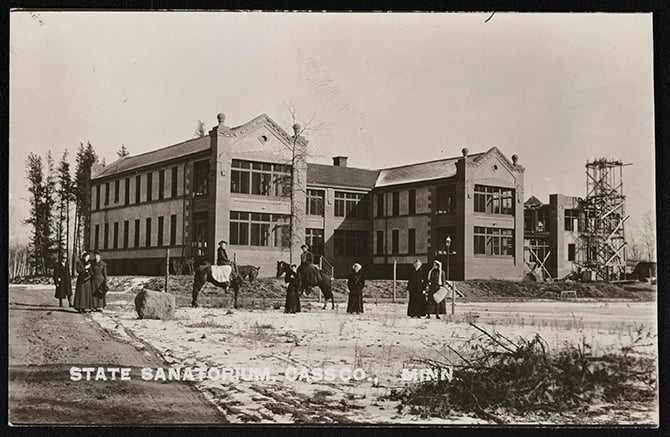
State Sanatorium, Cass County
Public domain
Holding Location
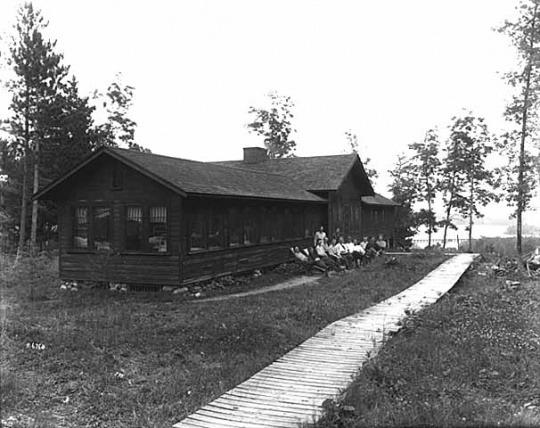
Cottage C, State Sanatorium, Walker
Public domain
Holding Location
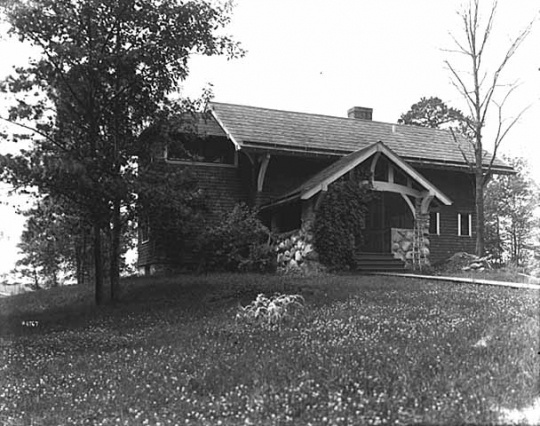
Superintendent's cottage, State Sanatorium, Walker
Public domain
Holding Location

Group of patients, State Sanatorium
Public domain
Holding Location
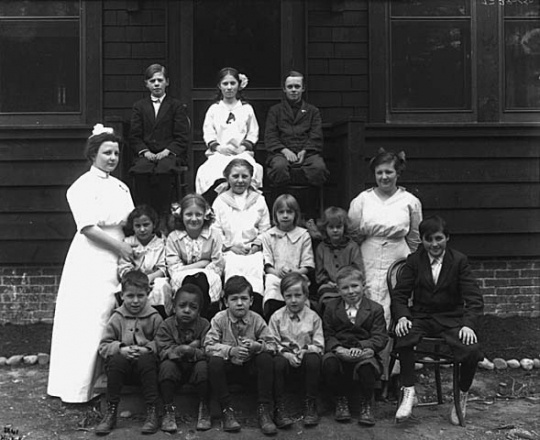
Children at State Sanatorium near Walker
Public domain
Holding Location
More Information

Children at State Sanatorium near Walker
Public domain
Holding Location
More Information
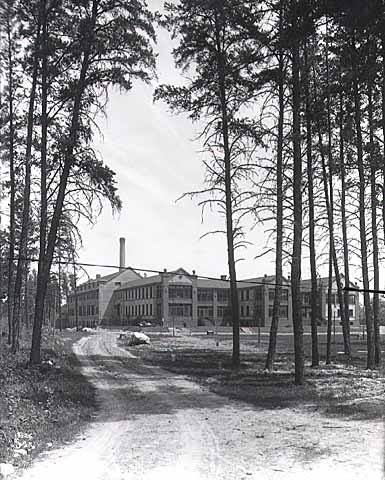
Main building from southwest, State Sanatorium near Walker
Public domain
Holding Location
More Information
Related Articles
Turning Point
With the introduction of antibiotics in 1946, tuberculosis cases plummet, leading to the closure of the Minnesota State Sanatorium for Consumptives in 1962.
Chronology
1887
1906
1962
2001
Bibliography
Anderson, Rolf T. "Minnesota State Sanatorium for Consumptives." National Register of Historic Places Registration Form, September 1996. State Historic Preservation Office, Minnesota Historical Society, St. Paul.
Lundquist, Monica. "Ah-Gwah-Ching: Land ready and waiting for a developer." Brainerd Dispatch, November 10, 2010.
Silverman, Kenneth. Edgar A. Poe: Mournful and Never-ending Remembrance. New York: HarperCollins, 1991.
Related Resources
Primary
Oral History Interview Transcripts, 1970s
Minnesota State Sanatorium for Consumptives
State Archives Collection, Minnesota Historical Society, St. Paul
Description: Transcripts of interviews with thirty-one former patients and staff of the sanatorium and nursing home.
Patient Records, 1908–1975
Minnesota State Sanatorium for Consumptives
State Archives Collection, Minnesota Historical Society, St. Paul
Description: Individual records of patients who were treated at the Minnesota State Sanatorium for Consumptives.
Photographs and Architectural Drawings, c.1927–1981
Minnesota State Sanatorium for Consumptives
State Archives Collection, Minnesota Historical Society, St. Paul
Description: Photographs and architectural drawings documenting the buildings, staff, patients, and activities of the sanatorium.
RC313.M6 A3
The Pine Knot, 1914–1925
Description: A monthly periodical published by the patients of the Minnesota State Sanatorium for Consumptives, or Ah-Gwah-Ching.
RC313.M6 A32
The Moccasin, April 1938–April 1948.
Description: A monthly periodical published by the patients of the Minnesota State Sanatorium for Consumptives, or Ah-Gwah-Ching.
Secondary
100 Years of Caring: Minnesota State Sanatorium for Consumptives, 1907–1961; Ah-Gwah-Ching Nursing Home, 1962–1990; Ah-Gwah-Ching Center, 1991–2007. [Minnesota, s.n.], 2007.
Gardner, Denis. "Minnesota State Sanatorium for Consumptives, Cass County." Minnesota History 59, no. 7 (Fall 2005): 271.
http://collections.mnhs.org/MNHistoryMagazine/articles/59/v59i07p270-271.pdf
Lass, William E. "Minnesota: An American Siberia?" Minnesota History 49, no. 4 (Winter 1984): 149–155.
http://collections.mnhs.org/MNHistoryMagazine/articles/49/v49i04p149-155.pdf
Myers, J. Arthur. "Entrance, Rise and Fall of Tuberculosis in Minnesota." Minnesota Medicine 60, no. 9 (September 1977): 679–684.
———. Invited and Conquered: Historical Sketch of Tuberculosis in Minnesota. [St. Paul: Minnesota Public Health Association], 1949.
Oliver, Skip. A Brief History of the Minnesota State Sanatorium/Ah-Gwah-Ching Nursing Home, 1907–1982: In Commemoration of Our 75th Diamond Jubilee. Ah-Gwah-Ching, MN: [s.n.], 1982.
Staumanis, Andris. "A History of the Ah-Gwah-Ching Treatment Center." Minnesota Public Radio, July 26, 2004.
http://news.minnesota.publicradio.org/features/2004/07/26_straumanisa_agcsidebar/
Wilson, Leonard G. "The Rise and Fall of Tuberculosis in Minnesota." Bulletin of the History of Medicine 66 (1992): 16–52.
Web
The Minnesota Historical Society's Greatest Generation. Moving Pictures initiative. Film: My Grandma Lucy.
http://people.mnhs.org/mgg/story.cfm?storyid=675&bhcp=1
The Minnesota Historical Society's National Register Properties. Minnesota State Sanatorium for Consumptives (Ah-Gwah-Ching).
http://nrhp.mnhs.org/NRDetails.cfm?NPSNum=01000766
Minnesota Historical Society, Placeography. Minnesota State Sanatorium for Consumptives.
http://www.placeography.org/index.php/Minnesota_State_Sanatorium_for_Consumptives,_Walker,_Minnesota
"Recent Acquisition: WPA Art from Ah-Gwah-Ching." Collections Up Close Podcast and Blog, Minnesota Historical Society, St. Paul, January 29, 2008.
http://discussions.mnhs.org/collections/2008/01/recent-acquisition-wpa-art-from-ah-gwah-ching/








